SUICIDE TERRORISM
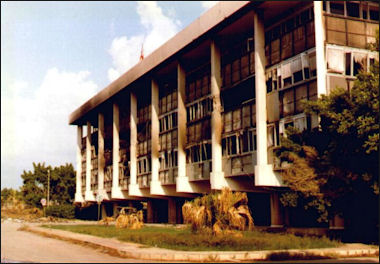
Marine Barracks after 1983 attack in Beirut
Suicide terrorists are usually people who wear or carry explosives in a belt, vest, backpack or suitcases and detonate their explosives among other people, killing themselves in the process. They have ridden bicycles; been dropped off from motorcycles; and rammed cars and trucks, but mostly the just board a bus or wander into a crowd. They try to target places with large numbers of people and try their best to blend into the crowd. Some have even dressed like ultra-Orthodox rabbis to avoid detection. Others have donned Israeli military uniforms or dressed up like women so as not to arouse suspicion. But as the September 11th terrorists — and Kamikaze pilots in World War II — showed one does not necessarily need to strap explosives into one’s body to be a suicide terrorist, one can also do something creative like fly a plane into a building or ship.
Terrorist groups like suicide attacks because they are effective, simple and cheap to carry out and difficult to stop, especially when compared to a conventional or even guerilla military attack. Some also say that it also sends a political message of desperation and despair that is not conveyed in car bombing, kidnaping or plane hijacking.
According to The Economist: “Suicide terrorism, like the slippery concept of terrorism in general, is harder to define than it may appear. For instance, are the suicide bombings in Israel really so different from previous incidents in which Palestinian gunmen and knifemen (and the occasional Israeli) launched assaults that they had little hope of surviving? They were scarcely the first to sacrifice their own lives in order to take others.” [Source: The Economist, January 8, 2004]
According to a 2002 Pew Research Center poll, 74 percent of those asked in Lebanon said that suicide attack were sometimes justified. In Pakistan, the figure was 33 percent . By 2007 views had changed. At that time only 34 percent of those asked in Lebanon said that suicide attacks were sometimes justified. In Pakistan, the figure was 9 percent . In Bangladesh and Indonesia support for suicide bombing as a tactic was down by half. Only in the Palestinian territories did support for suicide missions remain high (70 percent of people there supported the tactic in 2007). For a while the Bush White House tried to replace the word “suicide bomber” with “homicide bomber.”
Early History of Suicide Terrorism
.jpeg)
The Assassins
Siege of Alamut (1256) In the first century AD, the Zealots and Sicarii, two Jewish sects, attacked the Roman occupiers of Judaea and their allies in public places.
The first recorded suicide attacks were carried out in the 11th and 12th centuries by the Assassins, a cult active in modern Iran and Syria from the 11th to the 13th centuries. Assassin attackers killed their targets (mainly Muslim rulers whom they considered apostates) at close range and with no escape routes. Their name comes from the Arabic hashishiyya; the drug's powers were thought to explain the Assassins' oblivious bravery. [Source: The Economist, January 8, 2004]
The Assassins were masters of disguise and stealth. They often masqueraded as soldiers or servants and worked themselves into a position of trust, sometimes taking months to achieve this, so they could easily kill their victim — a vizier, a prince, a religious leader, warrior or king. Almost all their assassinations were carried out with daggers. The Assassins looked down on poisons and weapons that could be used from a distance such as crossbows as cowardly. Those that carried out their missions were not expected to survive. Like modern suicide bombers they believed that their ultimate death would give them a free ticket to paradise. See Assassins Under Early History of Terrorism
Worrying about the threat of the Assassins was almost as bad as being assassinated. Sect followers were difficult to identify and trained to resist torture. It is said that those who were captured chose death before betraying other Assassins. Leaders who felt threatened by the Assassins were paranoid and distrustful of all those around them and some barricaded themselves in their homes. "By one single warrior on foot," wrote one Ismaili poet, "a king may be stricken with terror, though he owns more than 100,000 horsemen." The daggers of the assassins were named fidais, or faithful.
From the mid-18th century, other groups launched suicidal attacks against colonial rulers in India, Indonesia and the Philippines. Then there are the countless individuals who have died for a cause without taking others with them: think of Irish and Kurdish hunger-strikers, or of the human minesweepers despatched by Iran during its war with Iraq. [Source: The Economist, January 8, 2004]
Kamikaze Attacks
Kamikaze suicide attacks sunk 34 ships between October 1944 and the end of the war, and played a part in a the U.S. Navy's worst single day loss, at Okinawa. Named after a divine wind and "nature god" that saved Japan from a Mongol attack in the 13th century, kamikaze planes were usually ordinary service aircraft, loaded with bombs and extra fuel tanks that would explode on impact. They were the equivalent of human-powered cruise missiles, an idea not so different than the one behind the September 11, 2001 terrorist attack on the World Trade Center in New York.
Kamikaze pilots operated manned-flying bombs (“Oka”) and human-powered torpedoes (“Kaiten”) in addition to explosives-laden aircraft. The idea of the suicide attacks was a last ditch measure by the Japanese to inflict as much damage and carnage as possible to break the will of the Allied forces. The suicide bombers were part of a mission called Ten Go (Operation Heaven). Most kamikaze aircraft were aimed at ships, some where also aimed at American B-29 bombers.
Praising a kamikaze attack in June 1944 Tojo said: “The best thing about Japan is that all people will risk their lives and are not afraid to die...Making infinite use of this advantage, we can destroy the enemy with death squads, by which one airplane destroys one enemy vessel or one special submergible sinks one enemy vessel.”
Book: “Blossoms in the Wind” by Mordecai Sheftall (New American Library, 2005)
Film: “The Winds of God: Kamikaze” is a film about a couple of comedians who die in a bicycle accident and are reincarnated as kamikaze pilots.

Kamikaze plane
See Separate Articles KAMIKAZES AND HUMAN TORPEDOES factsanddetails.com KAMIKAZE PILOTS factsanddetails.com
Suicide Terrorism in the 1980s and 90s
The Economist reported: “Yet for all these partial precedents, there is something novel about the type of terrorism in which the terrorist's death is a necessary and essential part of his act, not just an incidental cost. This type arrived in Lebanon in the early 1980s. Before then, modern groups such as the IRA and ETA, the Basque separatist movement, planned to escape after (or before) their bombings, mortar attacks and so on. Hizbullah's campaign of suicidal car and truck explosions — one of which killed 241 Americans in Beirut in October 1983; 58 people died in a strike on a French barracks on the same day — changed the face of terror. [Source: The Economist, January 8, 2004]
“The fact that Hizbullah started the trend, and that its spread has coincided with the rise of other Islamic groups — Hamas, Palestinian Islamic Jihad (PIJ), al-Qaeda and others — has led some to surmise that Islamic fundamentalism somehow explains it. Proponents of this theory can cite the lengths to which some terrorists go to justify their attacks in Islamic terms, manipulating the precedents set by the Prophet and his companions and finessing the meanings of three key concepts: suicide, martyrdom and jihad. The Kurdish PKK, which has deployed suicide bombers in its quests for Kurdish autonomy and for the release of its captured leader, Abdullah Ocalan, is influenced less by Islam than by Marxist-Leninism. So too is the Popular Front for the Liberation of Palestine, which perpetrated the first suicide strike in Israel for more than two months on Christmas Day.
Suicide Attacks in Lebanon in 1983
In April 1983, 63 people were killed, including 17 Americans, when a van packed with explosives and driven by a suicide bomber exploded outside into United States seaside embassy in Beirut. Islamic Jihad, a pro-Iranian group, took credit for the attack. In September 1983, a explosive-laden station wagon hit a concrete block before detonating in front of the United States embassy annex in East Beirut. Eleven people were killed including the driver. In September 1984, 23 people were killed, including two Americans, in a suicide car bomb attack on U.S. Embassy in Beirut. The mebassy had been moved after the 1983 attack.
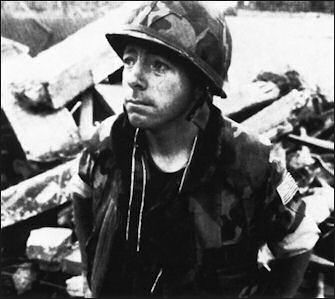
George_Pucciarelli
survivor of 1983 Marines Barracks attack
On October 23, 1983, 241 U.S. Marines and 58 French paratroopers were killed in bombings that took place just three seconds apart at the Marine barracks in Beirut and a French facility three miles away. The attack on the Marines barrack was carried out by a suicide driver in yellow Mercedes truck laden with 12,000 pounds of explosives. The truck broke through gates of a compound near Beirut’s international airport and drove right into the four-story concrete compound used as the Marine battalion headquarters. Another suicide driver hit the French facility. It was the largest death for U.S. military personnel in a single incident since Vietnam. No arrest were ever made and the terrorists are still believed to be in Lebanon. The United States left Lebanon in early 1984
Both attacks in Lebanon caught Washington by surprise, despite suicide bombings against the Iraqi Embassy in Beirut in 1981 and an Israeli military headquarters in south Lebanon in 1983. The bombing of the U.S. Marine barracks in Beirut still ranks as the largest loss of American military life in a single incident since the Battle of Iwo Jima in World War II. The tactic worked from the terrorists point of view. French and American forces withdrew from Lebanon soon after the attack. “We couldn't stay there and run the risk of another suicide attack on the marines,” wrote Ronald Reagan, then America's president, in his memoirs.
Hamas and other Israeli groups picked up suicide bombing techniques from Hezbollah when Hamas leaders were exiled to Lebanon in the early 1990s. See Terrorism in Israel
Iran-Iraq War Martyrs
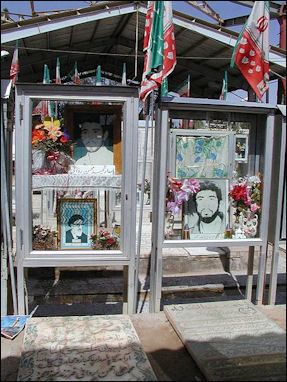
Martyr memorial in Yazd, Iran In the Iran-Iraq War in the 1980s mullahs in Iran recruited young men at neighborhood mosques and formed them into irregular forces of volunteers, or “basiji”, who carried suicide missions and human wave attacks. These young men were told that they would be admitted directly to heaven if they died in battle. Many though death be a wonderful uplifting experience.
The Basij wore red headbands with a phrase invoking the blood of an imam. Some wore socks that read “Death to Israel.” Many wore plastic “keys to Paradise” around their necks. Some took of their helmets in battle and held their Korans to their chests, believing this would shield them from shrapnel and bullets. Morgues were officially “Meraj” (“Places of Ascension”).
The Basij wore red headbands with a phrase invoking the blood of an imam. Some wore socks that read “Death to Israel.” Many wore plastic “keys to Paradise” around their necks. Some took of their helmets in battle and held their Korans to their chests, believing this would shield them from shrapnel and bullets. Morgues were officially “Meraj” (“Places of Ascension”). Before they went to fight they were given a “goodbye ceremony.” A respected clergymen or some such person told them that the next day there was to be an attack and many would not return. There was usually a lot of weeping at this point, followed by chanting and praying.
Hundreds of thousands of Iranian men died as martyrs. The Basij formed human waves that cleared mines and confused the enemy, paving the way for the regular army to come through. There were reports of men who died because people rushed up to them and stuck their hands into the wounds in order to touch the warm blood of a martyr which was supposed to bring good things. One basij, who was 14 when joined the war, told V.S. Naipul he was part of a regiment of 1,400 men, of which only 400 survived. He said he was wounded the twice. The second time he received some shrapnel in the head and went blind for several months and recovered after he prayed a shrine. After that he asked to go back to the front.
Parents were proud their children if they died as martyrs. A mother of two sons who died told National Geographic, “We are proud of our lost children. We hold our heads high, thanks be to Allah. My sons are following in the path of Imam Husayn [a revered Shiite martyr], and when they are in the other world they are helped by Iman Husayn.
Almost every town and village had special martyr cemeteries where the martyrs were buried. These cemeteries got bigger and bigger as the war progressed. Families visited the graves on Friday and decorated the graves with green and red flags (green for Islam and red for blood), small shrines, piles of fruit, flowers, and likenesses of the deceased. Sometimes during the funerals mother hurled themselves into the graves, where their sons were buried. Families of martyrs received free apartments and stipends of $120 a month.
Mass funerals for several thousand individuals were held when the remains couldn’t be identified. Well-known martyrs had streets named after them and huge billboard-like murals raised in their honor. In some places you could find martyr’s fountains with bubbling red-dyed water intended to look like flowing and splattering blood. Behind the fountains were photographs of local martyrs who fell in battle.

LTTE Black Tiger Picture Gallery 2004
Tamil Tigers and Suicide Missions
The Tamil Tigers of Sri Lanka have set off more suicide bombs than any other organization. As of 2002, by one count, they had carried 220 suicide bombing missions that killed , more 1,500 people. By contrast Hamas had set off 70 bombs at the same point in time. Rohan Gunaratna, an expert on terrorism at St. Andrews University in Scotland, told the New York Times, “of all the suicide capable terrorists we have studied they are the most ruthless and most disciplined.” The Economist called reported: “The single most prolifically suicidal terrorist group is the LTTE, or Tamil Tigers.
The Economist reported: “The single most prolifically suicidal terrorist group is the LTTE, or Tamil Tigers. In the course of their attritional struggle for an independent Tamil state in northern Sri Lanka, the LTTE has, among scores of other attacks, bombed the World Trade Centre in Colombo in 1997 and assassinated two heads of state. LTTE suicide missions, which began in 1987, are inspired more by cultish devotion to Velupillai Prabhakaran, the group's leader, than by religion. [Source: The Economist, January 8, 2004]
The Tamil Tigers are credited with popularizing the suicide mission as a military tactic. Suicide bombs had been used in isolated instances in the Middle East (most notably in the attack on the Marine barracks in Lebanon) but until the 1990s most attacks were car bombings or conventional ambushes or infiltrations. By contrast the Tamil Tigers used suicide bombing in a systematic way beginning in the late 1980s to fight an enemy that vastly out outnumbered them.

LTTE Black Tiger Picture Gallery 2004
One Captain Millar is credited with being the first suicide bomber. In July 1987, he plowed a truck full of explosive into an army camp, killing 40 Sri Lankan soldiers. Others on suicide bombers carried out assassinations, bombed buildings and attacked ships. One even attacked Sri Lanka’s most scared Buddhist site, the Temple of the Tooth. To carry out the missions the Tigers have used men, women, children, animals, boats, motorized rickshaws, parcels, cars and trucks. Some have argued that the September 11th attacks have their roots in Tamil Tiger methods and tactics.
It is widely believed the Middle Eastern and militant Muslim groups such as Al-Qaida studied Tamil Tiger suicide missions. The attack on the Cole in Yemen by Al-Qaida in 2000 is believed to have been copied from Tamil Tiger attack on a Sri Lankan Navy ship in 1991. The Tigers also pioneered the use of sophisticated suicide body suits and surveillance techniques and developed methods to get close to targets.
The Tamil Tiger developed suicide mission as an offensive weapon. Ironically the main goal of suicide missions was to frustrate the military and the political leadership of the enemy with a minimum loss of life to the perpetrators (the loss of one suicide bomber is much less than losses sustained launching a military offensive). The word used to describe a Tamil Tiger suicide mission — “thatkodai” — means to “give yourself.” One Sri Lankan expert on the Tigers told the New York Times, “It is a gift of the self, self-immolation, or the self-gift. The person gives him or herself in full.”
Sri Lanka Tamils have traditionally had among the highest suicide rates in the world while Muslims traditionally haven’t had very high suicide rates.

Suicide Bombing in Israel
The tactic of suicide bombing emerged in Israel in the mid 1990s and was a major security problem in the late 1990s and early 2000. The numbers peaked after the start of the second intifada, in September of 2000. Between then and the middle of 2003 suicide bombers were responsible for almost half of the approximately 750 deaths in terrorist attack. [Source: Bruce Hoffman, The Atlantic Monthly, June 2003]
Bruce Hoffman wrote in The Atlantic Monthly: I walked through Jerusalem with two police officers... They described the first major suicide-terrorist attack in the city, which occurred in February of 1996, early on a Sunday morning — the beginning of the Israeli work week. The driver of the No. 18 Egged bus was hurrying across a busy intersection at Sarei Yisrael Street as a yellow light turned red. The bus was about halfway through when an explosion transformed it into an inferno of twisted metal, pulverized glass, and burning flesh. A traffic camera designed to catch drivers running stop lights captured the scene on film. Twenty-five people were killed, including two U.S. citizens, and eighty were wounded. [Source: Bruce Hoffman, The Atlantic Monthly, June 2003]
On the objective of suicide attacks in Israel, Sheikh Ahmad Yassin, the spiritual leader of Hamas, said in 2001. "The Israelis ... will fall to their knees...You can sense the fear in Israel already; they are worried about where and when the next attacks will come. Ultimately, Hamas will win." Ismail Haniya, another Hamas leader, was quoted in March 2003 in The Washington Post as saying that Jews "love life more than any other people, and they prefer not to die."
“This perceived weakness of an ostensibly powerful society,” Hoffman wrote, “has given rise to what is known in the Middle East as the "spider-web theory," which originated within Hizbollah, the Lebanese Shia organization, following a struggle that ultimately compelled the Israel Defense Forces to withdraw from southern Lebanon in May of 2000. The term is said to have been coined by Hizbollah's secretary general, Sheikh Hassan Nasrallah, who described Israel as a still formidable military power whose civil society had become materialistic and lazy, its citizens self-satisfied, comfortable, and pampered to the point where they had gone soft. IDF Chief of Staff Moshe "Boogie" Ya'alon paraphrased Nasrallah for the Israeli public in an interview published in the newspaper Ha'aretz last August. "The Israeli army is strong, Israel has technological superiority and is said to have strategic capabilities, but its citizens are unwilling any longer to sacrifice lives in order to defend their national interests and national goals. Therefore, Israel is a spider-web society: it looks strong from the outside, but touch it and it will fall apart." Al Qaeda, of course, has made a similar assessment of America's vulnerability.
Suicide, Martyrdom and The Koran
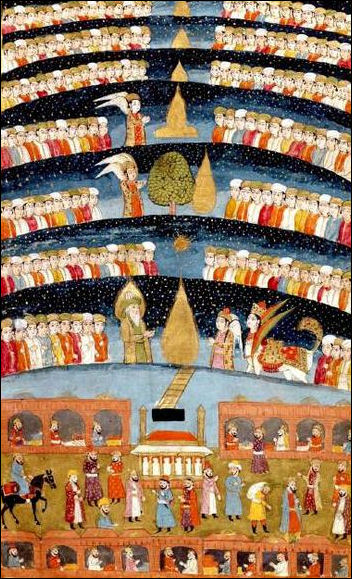
Mohammed's Seven Paradise According to The Economist: “The Koran is unequivocal about suicide: as a mark of despair in Allah, it earns eternal damnation. On the other hand, martyrdom — death in jihad, incurred in Allah's name — earns eternal bliss: “Think not of those who are slain in Allah's way as dead. Nay, they live, finding their sustenance in the presence of the Lord.” The Koranic outline of the martyr's rewards in paradise is elaborated in the hadith (prophetic sayings and anecdotes) and has been embellished by generations of scholars. Islamic suicide bombers go to their deaths variously expecting to meet the Prophet and to see the face of Allah. Their sins will be forgiven, and they can intercede for their relatives on the day of resurrection. They will live amid rivers of wine and honey, and be married to 72 black-eyed virgins. [Source: The Economist, January 8, 2004]
Muslim clerics who support suicide terrorism claim the suicide bombers are martyrs (“shaheed”), which are greatly admired in Islam, and insist they are not escaping life but are helping their people and their children by making a sacrifice. They also insist that the suicide bombings are a form of self defense and that all Israelis, Jews, Americans, Westerners are an enemy and thus fair game in a jihad battle. In Arab cultures the word “suicide bomber,” and its Arabic equivalent, are not used. Instead they are referred to as martyrs (“shaheed”).
Traditional Muslim theology regards suicide and the killing of noncombatants as unforgivable sins. According to a sacred Muslim commentary, “Whoever kills himself with an iron weapon, then the iron weapon will remain in his hand, and he will continuously stab himself in his belly with it in the Fire of Hell eternally forever and ever.” The Koran also states women and children are not to be killed; corpses are to be left undisturbed; and prisoners are to be treated with respect and are invited to embrace Islam.
Fighters were not expected to go into battle with the expectation of dying and being a martyr. In one of the sayings of the Prophet, God tells a “martyr” who is rejected: “You gave your life so people could remember you as a cause. You didn’t do it to satisfy me.”
Virgins and Paradise for Martyrs
Suicide bombers are told that martyrdom is a righteous deed that will wash away their sins, earn them a shortcut to heaven, where they will enjoy a marriage to”72 dark-eyed virgins in paradise,” and guarantee places in heaven for 70 of their relatives. They are told they will not feel any pain after the first drop of their blood has been shed, they will escape tortures of the grave, they will see the face of God and they will be reunited in heaven with loved ones killed by their enemies. Some say that because a martyr doesn’t die he doesn’t commit suicide.
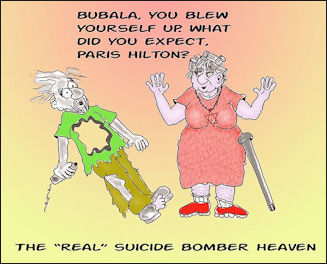
real suicide bomber heaven On the pleasures waiting for martyrs in paradise, the Koran reads:
Spend eternity in gardens of tranquility
Youths of never-ending bloom will pass
around to them decanter, beakers full of
sparkling wine...
And suck fruits as they fancy.
Bird meats as they relish.
And companions with big beautiful eyes
Like pearls within their shells...
One Muslim man told Newsweek: “When a martyr dies, the body smells very sweet. And insects don’t normally eat the body as they do in death. I’ve seen corpses where the heads were chopped off — not by man, but by angels.” It is not clear where the number “72" came from. Scholars say it came from an unreliable source from the early Islamic period.
One hadith reads: “Paradise lies under the shade of swords.” Almost universally, it has been said, suicide bombers and their families think the bombers go to paradise is they successfully complete their missions. When asked many young Muslim extremist say they would be willing to die in a jihad and their parents would be "very happy" too.
Shiites, Suicide Terrorism and the Smile of Joy
Some Shiite Muslims believe that the death of Hussein, the grandson of the Prophet Mohammed and a revered martyr to Shiites, serves as a precedent for suicide terrorism. Hussein was killed in a battle against a Umayyad clam in A.D. 680. When he concluded that his small band of fighters was no match for the huge army they faced, Hussein said: “O people, the Apostle of God, said during his life, “He who sees an oppressive ruler violating the sanctions of God — and does not show zeal against him in word or deed, God would surely cause him to enter his abode in the fire.”
The argument suggested by the death by Hussein, some say, is that entering a battle knowing you are going to die is not only laudable but obligatory in some situation and whether you die from a suicide bomb or a killed by an enemy doesn’t really matter. These arguments contradict many teachings in the Koran. Mohammed, for example, said the martyrdom was not something that people did willingly. It was the will of God, not humans. The Koran also makes a clear distinction between fighters and civilians. It makes allowances for collateral damage but sharply denounces deliberate attempts to kill civilians.
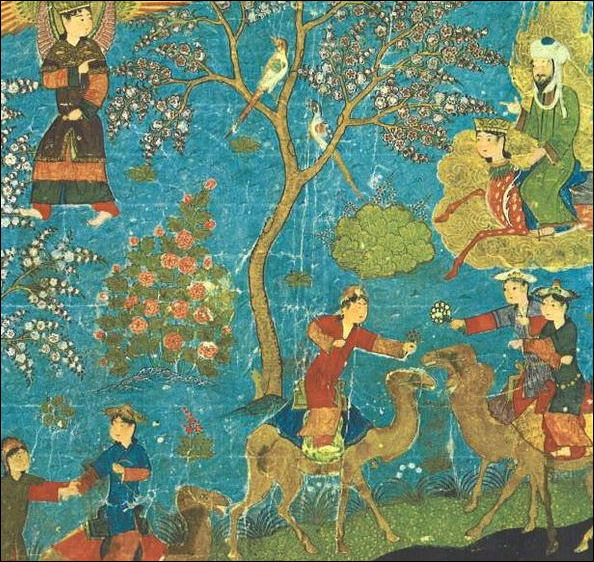
Mohammed visiting Paradise
Bruce Hoffman wrote in The Atlantic Monthly: “Suicide terrorists are often said to have gone to their deaths smiling. An Israeli policeman told me, "A suicide bomber goes on a bus and finds himself face-to-face with victims and he smiles and he activates the bomb — but we learned that only by asking people afterwards who survived." This is what is known in the Shia Islamic tradition as the bassamat al-farah, or "smile of joy" — prompted by one's impending martyrdom. It is just as prevalent among Sunni terrorists. (Indeed, the last will and testament of Mohammed Atta, the ringleader of the September 11 hijackers, and his "primer" for martyrs, The Sky Smiles, My Young Son, clearly evidence a belief in the joy of death.) [Source: Bruce Hoffman, The Atlantic Monthly, June 2003]
What is Martyrdom and What is Suicide Terrorism?
According to The Economist: Should suicide “bombings count as sinful suicide or glorious martyrdom? That partly depends on how the volatile concept of jihad is defined. For many Muslims, jihad is principally an internal struggle. But, especially since the advent of Wahhabism, a branch of Sunni Islam that evolved in the 18th century, the notion of jihad as external warfare has been revived. Despite Koranic injunctions to the contrary, some radical Islamic thinkers have justified the killing of civilians, and of other Muslims, in the name of jihad. [Source: The Economist, January 8, 2004]
“Likewise, suicide bombings — or “martyrdom operations”, as some of their exponents prefer — have been rationalised as a praiseworthy embrace of death at the hands of the enemy, and as a legitimate tactic in extremis. Among other sophistic arguments, some terrorists say that Allah, and not the bomber, decides whether the latter will die, and whether women and children will perish with the shaheed (martyr). Some scholars believe that a newly strident view of martyrdom, adopted by many Shia Muslims after the Iranian revolution of 1979, informed the new species of terrorism that Hizbullah, a Shia group, developed not long afterwards.
“A firm belief in paradise is clearly an asset for anyone strapping on a bomb. But all these theological somersaults suggest that religion may be as much a hurdle, which the perpetrators of “martyrdom operations” need to overcome, as a motive for their violence. Hizbullah's clerics, for example, have always been squeamish about suicidal missions. And, quite apart from these qualms, there is another compelling reason to doubt that Islamic fundamentalism accounts for the rise of suicide bombing: non-Muslims are among its most devoted practitioners.
See Jihad

Mohammed visiting Hell
Effectiveness, Rationale and Logic of Suicide Terrorism
The rational for suicide attacks is that they help the weak fight the strong. Those who use the methods do not have sophisticated tanks, missiles Apache helicopter gunships and F-16s and can not compete with them while the Israelis and Americans and targets of such attacks use their military superiority to bully the Palestinians and Muslims and other victims. Thus suicide bombing is one of the only ways that perceived victims such as the Palestinians can fight back and have some success against their enemy.
Bruce Hoffman wrote in The Atlantic Monthly: “The fundamental characteristics of suicide bombing, and its strong attraction for the terrorist organizations behind it, are universal: Suicide bombings are inexpensive and effective. They are less complicated and compromising than other kinds of terrorist operations. They guarantee media coverage. The suicide terrorist is the ultimate smart bomb. Perhaps most important, coldly efficient bombings tear at the fabric of trust that holds societies together. All these reasons doubtless account for the spread of suicide terrorism from the Middle East to Sri Lanka and Turkey, Argentina and Chechnya, Russia and Algeria — and to the United States. [Source: Bruce Hoffman, The Atlantic Monthly, June 2003; Hoffman is a professor at Georgetown University and author of "Inside Terrorism."]
“Terrorism is meant to produce psychological effects that reach far beyond the immediate victims of the attack. "The Scuds of Saddam [in 1991] never caused as much psychological damage as the suicide bombers have," says Ami Pedahzur, a professor of political science at Haifa University and an expert on political extremism and violence who manages the National Security Studies Center's terrorism database. As the French philosopher Gaston Bouthoul argued three decades ago in a theoretical treatise on the subject, the "anonymous, unidentifiable threat creates huge anxiety, and the terrorist tries to spread fear by contagion, to immobilise and subjugate those living under this threat."
“The strategy of suicide terrorists is to make people paranoid and xenophobic, fearful of venturing beyond their homes even to a convenience store. Terrorists hope to compel the enemy society's acquiescence, if not outright surrender, to their demands. This is what al Qaeda hoped to achieve on 9/11 in one stunning blow — and what the Palestinians seek as well, on a more sustained, if piecemeal, basis.”

Bus 19 in Israel
The Economist reported: “Terrorists have some reasons to believe that such onslaughts work. Chief among those is the withdrawal of French and American forces from Lebanon after Hizbullah's atrocities. “We couldn't stay there and run the risk of another suicide attack on the marines,” wrote Ronald Reagan, then America's president, in his memoirs. Other apparent concessions to suicide campaigns, such as temporary Israeli withdrawals from Palestinian territory in the mid-1990s, have been more ambiguous; but terrorists tend to interpret history in a way that burnishes their own efforts. For their part, the kamikaze pilots helped to convince America that Japan would fight to the last soldier. This conviction was partly why atomic bombs were dropped on Hiroshima and Nagasaki. [Source: The Economist, January 8, 2004]
“Like other forms of terrorism, suicide attacks are designed to impress the terrorist's own constituency, as well as to coerce their opponents — and “martyrs” have a particular propaganda value. Some groups have embraced suicide to keep pace with rival outfits, with whom they are competing for recruits and support. This was the case in Lebanon, where other organisations, including some secular ones, imitated Hizbullah's new technique. Likewise, various offshoots of Yasser Arafat's Fatah movement, which once preferred ambushes and guerrilla attacks, took up “martyrdom operations” after the suicidal “successes” of PIJ and Hamas.
“The prevalence of suicide in contemporary terrorism has helped to persuade some observers that outrages from Rabat to Riyadh to Grozny are all the handiwork of al-Qaeda — just as, in the 1980s, conspiracy theorists believed that terrorism across the globe was being orchestrated by the Soviet Union. This sort of talk suits Mr bin Laden; and the idea of a single, coherent enemy also has some appeal for westerners. In reality, suicide has spread not because of central co-ordination, but because it works. The term “suicide bombing”, with its connotations of unhinged despondency, obscures the essential rationality of the method. Some in Israel and America, arguing that it also obscures the victims, prefer “homicide bombings”.
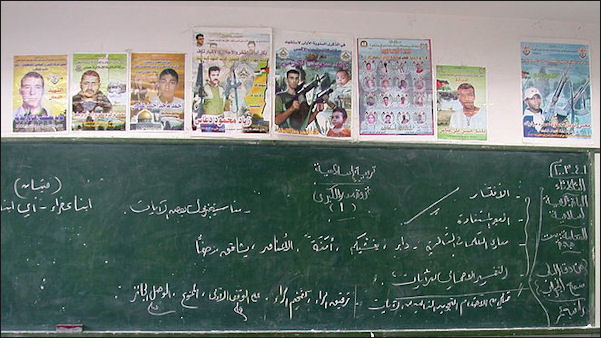
Posters of suicide bombers in a classroom in Tul Karem
Suicide Terrorism as an Effective Military Tactic
The Economist reported: “Suicide bombing is a corporate effort: in this respect, the closest historical analogy may be the kamikaze pilots who trained as a cadre to terrorise the American fleet in the Pacific in 1944-45. And suicide appeals to these groups principally because it is a good way to kill large numbers of people. Robert Pape, of the University of Chicago, calculates that between 1980 and 2001 13 people died on average in every suicide attack, whereas just one was killed in other terrorist incidents — excluding September 11th, which would make the death ratio much starker. For those whose aim is maximum destruction, not just maximum publicity, it is the natural choice. [Source: The Economist, January 8, 2004]
“This special deadliness is partly the result of the suicide bomber's ability to adapt the place and time of his detonation to the last minute. As Bruce Hoffman of Rand, a think-tank, puts it, the suicide bomber is “the ultimate smart bomb, or human cruise missile”. If the bomber is spotted, he can detonate instantly. Fathi Shiqaqi, a founder of PIJ, used these unique advantages to justify “martyrdom operations”. The Palestinian groups regard suicide attacks as a way to counteract Israel's conventional military superiority.
“Suicide is also a flexible technology. Where Hizbullah used cars and trucks to attack well defended installations, Hamas, PIJ and some Chechen bombers mingle among civilians, their concealed belts or vests loaded with explosives and shrapnel. The LTTE, which turned to suicide because other methods were having frustratingly little impact, has despatched suicide bombers in boats, and to conduct assassinations: much easier if the assassin has no intention of escaping. Whoever sent the two suicide bombers who narrowly failed to kill General Pervez Musharraf, Pakistan's president, also on Christmas Day, understood that advantage.
Counter-intuitive though it may seem, terrorists also regard suicide attacks as low-risk, given the scale of devastation they can inflict. As Ayman al-Zawahiri, Osama bin Laden's right-hand man, has put it, “the method of martyrdom operations [is] the most successful way of inflicting damage against the opponent and least costly to the mujahideen in terms of casualties.” No accomplices are needed for rescues or getaways. Nor is there much danger of bombers betraying their comrades: if LTTE emissaries survive the explosion, they bite a poison capsule.
As well as these tactical benefits, suicide terrorism offers a strategic one. After the debacle in Somalia in 1993, Mr bin Laden concluded that sensitivity to casualties was the heel of the American Achilles; Palestinian terrorists think something similar about Israel. Suicide bombings juxtapose these groups' disdain for life with their victims' supposed love of it. This helps to create the impression of an undeterrable enemy, one freed by his self-disregard to strike anywhere: “I depend on death,” says a would-be suicide bomber in “The Secret Agent”, “which knows no restraint and cannot be attacked.”
Simultaneous bombings magnify this sense of vulnerability; so do sequences of attacks. As Mr Pape observes, almost all suicide missions occur as part of campaigns, often, as with the regular attacks on the Americans and their allies in Iraq, designed to liberate territory occupied by democracies. (Democratic governments, it is presumed, are more likely to be swayed by their citizens' deaths than others.) The cumulative effect of such campaigns was aptly described by Josephus, a classical historian who chronicled the anti-Roman insurgency in Judaea: “The panic created was more alarming than the calamity itself; everyone, as on the battlefield, hourly expected death. Men kept watch at a distance on their enemies and would not trust even their friends...Everyday activities become perilous; ordinary life begins to seem untenable.”
Image Sources: Wikimedia Commons, Israel Defense Forces
Text Sources: New York Times, Washington Post, Los Angeles Times, Times of London, The Guardian, National Geographic, The New Yorker, Time, Newsweek, Reuters, AP, AFP, Wall Street Journal, The Atlantic Monthly, The Economist, Global Viewpoint (Christian Science Monitor), Foreign Policy, Wikipedia, BBC, CNN, NBC News, Fox News and various books and other publications.
Last updated July 2012
